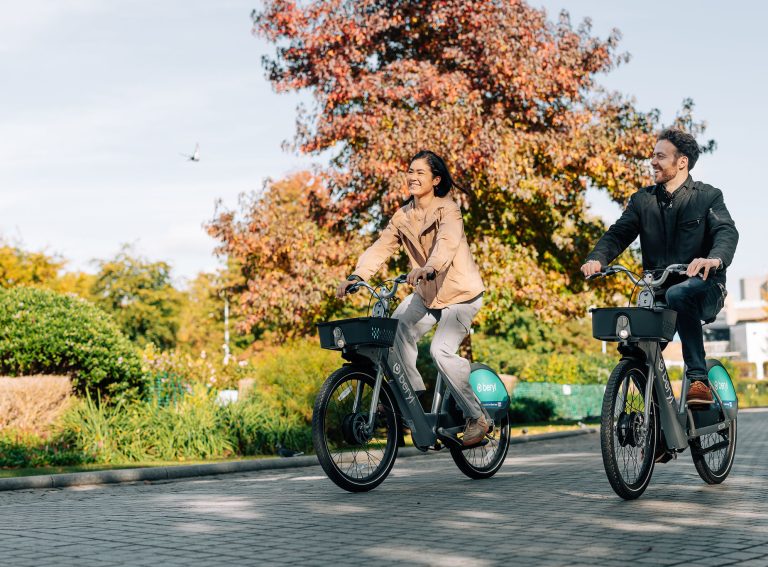Authors: Dr Ianto Guy, Principal Vehicle Safety and Technology Consultant at TRL and Dr George Beard, Head of New Mobility at TRL
Last month (April 2024), a consultation from the UK Department for Transport (DfT) closed on “Smarter Regulation” for Electrically Assisted Pedal Cycles (EAPCs).
The consultation invited views on two potential changes to the regulations for EAPCs – an increase in the maximum continuous rated motor power from 250W to 500W, and allowing speed control using a throttle up to the maximum assisted speed of 15.5mph. But will changes of this nature have a transformational effect on micromobility in the UK, or is this just tinkering for the sake of it?
In the UK the micromobility market remains hampered by outdated regulations which have failed to keep pace with trends in micromobility. EU Regulation 168/2013 (the ‘L-category’) is the regulatory home for all powered light vehicles with 2, 3 or 4 wheels and a seat. Intended originally as the approval route for mopeds, motorcycles, trikes, quads and microcars, the L-category is a broad church of enormously diverse vehicle types. While the regulation has a much lighter touch than the equivalent regulation for passenger cars or trucks, it still represents a significant hurdle for the manufacturers of light vehicles. Though the requirements of the regulation are largely proportionate for faster, heavier machines like mopeds or motorcycles, the type-approval system seems perhaps a little heavy handed for slower, lighter machines with low top speeds.
For e-scooters and other devices without seats, specifically excluded from EU Regulation 168/2013, the regulatory situation is much worse – lacking a regulatory home, they have no route to mass legalisation. The recent launch of the Swifty GO GT500 has demonstrated that a route to approval does exist for standing machines, in the form of the Motorcycle Single Vehicle Approval (MSVA) system, but this is hardly a scalable option if standing micromobility machines are to become a transformational alternative to car use.
By contrast, e-bikes, also excluded from Regulation 168/2013 but with their own specific set of regulations, have developed mass market appeal, with millions of units sold across the EU and UK, thanks in part to a relatively liberal scheme of regulation that effectively treats them the same as conventional bicycles provided their maximum motor assisted speed is 15.5mph (25km/h) or less and their “continuous rated motor power” is no more than 250W (classed as EAPCs).
E-bikes with higher continuous rated motor power and/or higher top speeds are within the scope of 168/2013 meaning they are subject to formal type approval in the same way as motorcycles and other L-category vehicles and are subject to the same user restrictions around licensing, insurance, helmet use etc. as mopeds. Consequently, these types of e-bike have proved much less popular.
More power – or is it?
The first of the DfT’s proposals on which they sought views was to increase the maximum continuous rated power for EAPCs to 500W, from the current 250W limit. The DfT’s core rationale for this proposal is that it will “make it easier for cyclists using EAPCs to ride up hills and gradients” with the ultimate goal of enabling more people to cycle, in particular those who live or work in hilly areas, those who are less physically fit, and those who use / want to use e-cargo bikes for transporting heavier loads.
We of course support these objectives – micromobility has great potential to help transform our transport system for the better and key to that is ensuring it is accessible to as broad a range of users as possible and suitable for as broad a range of use cases as possible. There is strong evidence of the benefits of e-bikes for public health and the environment, and so measures which can further increase adoption and realisation of those benefits should be commended. Unfortunately, however, increasing the continuous rated power of EAPCs to 500W is unlikely to help in achieving these goals.
We are highly sceptical about the value of continuous rated power limits for EAPCs. Proponents of regulating power maintain that it is a safeguard against excessively fast machines – especially those that might be tampered with – and helps to ensure that the machine remains controllable under acceleration. Controllability under acceleration is far more to do with having a smooth throttle response. As for tampering – power limits are just as easily overcome as speed limits. Indeed increasing the top speed of the machine of necessity increases its output power, so a power limit is no defence here.
“Power”, in an engineering sense, is a measure of the rate at which work can be done. When we talk about power in a colloquial sense, we’re often talking about torque – the rotational force that determines how fast a vehicle accelerates, or how steep a hill it can climb. But mechanical power is really a composite of torque and speed, or force and speed if you prefer. The output power of an internal combustion engine is limited by the efficiency with which fuel can be burned – if you want more power, you either have to burn more fuel by making the engine bigger, or you have to play expensive games making the combustion process more efficient by adding turbo chargers or smoothing the flow of air through the inlet manifold so you can burn more fuel. So, to a significant extent, limiting an engine’s size will cap its output power. If you want more power from an electric motor, you have to turn up either the supply voltage or the current. You can do both of these without having to modify the motor at all, although you will eventually reach a point where the motor overheats and starts emitting expensive smoke.
You would be forgiven for thinking that “maximum continuous rated power”, a measure widely used in regulations, was an indication of the maximum amount of power that a particular motor can produce, but you should be suspicious of the “continuous rated” part of that description. The emission of expensive smoke is such a well-known failure mode in the electric motor world that a standard, EN60034, was developed to require the manufacturers of electric motors to declare a power “rating” at which their motor is thermally stable, i.e. it doesn’t heat up and emit smoke, when run continuously at said power. This is to stop unscrupulous motor manufacturers from selling a “250W” motor that can only reach that power by being driven with a higher voltage or current than it is able to accommodate without overheating. But that 250W rating is an arbitrary value that is nominated by the manufacturer, not an indication of the peak power the motor can achieve. In reality therefore, EAPC motors today could, if desired, already produce peak powers well in excess of 250W, and thus increasing that arbitrary limit to 500W will have no practical effect on the motors that are available on the market. Therefore we believe the question that should be asked is not, what arbitrary power limit should we apply, but why are we regulating continuous rated power at all?
To pedal or not to pedal
The second proposal from the DfT is to allow the use of throttle assistance up to 15.5mph; here the rationale is that it could “help make EAPCs more accessible”. This includes for example enabling use of EAPCs as mobility aids by some disabled people, or supporting greater use by people who are less physically fit.
Potential benefits to e-cargo bike riders are also suggested. In principle, we are supportive of allowing EAPCs to have throttle assistance up to 15.5mph – however, there is some potential for unintended consequences in doing this. One key challenge is with regards to enforcement – if the requirement to pedal at speeds above about 4mph is removed, then this could make it more difficult in future for the police to distinguish between EAPCs and mopeds, for example. Both would be throttle controlled and, visually, may look very similar, but one would have far less stringent technical and road user regulations (i.e. no requirement for a licence, helmet or insurance, and allowed to be used in cycle lanes) and the other would be subject to motor vehicle regulations (i.e. mandatory licence, helmet and insurance, and not allowed in cycle lanes). This challenge is likely not insurmountable, but a solution needs to be considered alongside any proposed changes.
Is there a better way?
We are strong advocates for micromobility, when designed, implemented and regulated in the right ways. In the Queen’s Speech in May 2022, the government announced their intention to create a new, low-speed, zero-emission vehicle (LZEV) category – independent from existing cycle and motor vehicle regulations, creating a new regulatory home for ‘new’ vehicle types such as e-scooters and other forms of micromobility. We strongly encourage the government to press forward with these plans as we believe it is the best approach for creating new regulations which are fit-for-purpose for a range of innovative micromobility devices. This could in theory include, for example, EAPC-like machines with throttles. Our vision is for a flexible and proportionate approach to technical regulations that is performance-based by focusing on safety critical functions, and encourages innovation by enabling use of a range of low speed electric-powered devices with two, three, four (or more) wheels, with and without seats, and without a requirement for pedals. Arguably, this could lead to a similar enforcement challenge to that we have set out above – however, we believe it is far more efficient and effective to develop a clear and comprehensive set of regulations which consider such enforcement challenges (and other things) from the outset so that appropriate solutions can be developed, rather than ‘retrofitting’ individual changes into existing regulations in a piecemeal fashion.











